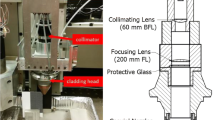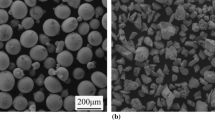Abstract
To explore the forming mechanism and the evolution laws of cladding geometry with process parameters on curved substrates for laser powder-fed additive manufacturing (LPF-AM) processes, based on the laser beam distribution and the cladding forming theory of horizontal and tilted substrates, analytical models for cladding geometric characteristics in the vertical and tilted postures of nozzles were established. LPF-AM experimental research on a curved substrate of AISI 304 steel was carried out, and the theoretical results were discussed and compared with the experimental data from the perspective of the curvature radius of the substrate, powder feed rate, scanning speed, and tilt angle of the nozzle. The results showed that the tilt angle of the nozzle was the most critical factor for the laser irradiation area and cladding width; moreover, the cladding width increased gradually as the tilt angle of the nozzle increased. The curvature radius of the substrate, powder feed rate, and scanning speed had a significant influence on the cladding height. Due to the effects of gravity, surface tension, and viscous shear force, the peak shift was proportional to the powder density and the tilt angle of the nozzle. The predicted values of the analytical models fit well with the experimental results. The prediction accuracies of the cladding width, cladding height, and peak shift theoretical models were 98.97%, 91.30%, and 76.85%, respectively. This study provides deeper insight into the ensuing cladding geometrical characteristics using LPF-AM on curved substrates.










Similar content being viewed by others
Availability of data and materials
We certify that we have participated sufficiently in the work to take public responsibility for the appropriateness of the experimental design and the collection, analysis, and interpretation of the data.
References
Huang YZ, Khamesee MB, Toyserkani E (2016) A comprehensive analytical model for laser powder-fed additive manufacturing. Addit Manuf 12:90–99
Zhu Y, Yang Y, Mu X, Wang W, Yao Z, Yang H (2019) Study on wear and RCF performance of repaired damage railway wheels: assessing laser cladding to repair local defects on wheels. Wear 430-431:126–136
Gamon W, Aniołek K (2020) Examination of the sliding wear of bronze coatings on railway buffer heads. Wear 448-449:203235
Sun YW, Hao MZ (2012) Statistical analysis and optimization of process parameters in Ti6Al4V laser cladding using Nd:YAG laser. Opt Lasers Eng 50:985–995
Wang XL, Deng DW, Zhang HC (2018) Effects of mass energy and line mass on characteristics of the direct laser fabrication parts. Rapid Prototyp J 24(2):270–275
Wang XL, Deng DW, Zhang HC (2016) Effects of mass energy and line mass on clad characteristics in the laser cladding process. Lasers Eng 34:1–14
Wang XL, Deng DW, Hu YB, Liu ZC, Zhang HC (2017) Analytical modeling and experimental investigation of laser clad geometry. Opt Eng 56(9):096104
Barekat M, Razavi RS, Ghasemi A (2016) Nd:YAG laser cladding of Co-Cr-Mo alloy on γ-TiAl substrate. Opt Laser Technol 80:145–152
Ansari M, Razavi RS, Barekat M (2016) An empirical-statistical model for coaxial laser cladding of NiCrAlY powder on Inconel 738 superalloy. Opt Laser Technol 86:136–144
Nabhani M, Razavi RS, Barekat M (2018) An empirical-statistical model for laser cladding of Ti-6Al-4V powder on Ti-6Al-4V substrate. Opt Laser Technol 100:265–271
Erfanmanesh M, Pour HA, Semnani HM (2016) An empirical-statistical model for laser cladding of WC-12Co powder on AISI 321 stainless steel. Opt Laser Technol 97:180–186
Liu HM, Qin XP, Huang S, Hu ZQ, Ni M (2018) Geometry modeling of single track cladding deposited by high power diode laser with rectangular beam spot. Opt Lasers Eng 100:38–46
Zhao Y, Yu TB, Sun JY, Xi WC, Bi XX (2018) Effect of laser cladding on forming qualities of YCF101 alloy powder in the different lap joint modes. Int J Adv Manuf Technol 96:1991–2001
Yu TB, Zhao Y, Sun JY, Chen Y, Qu WR (2018) Process parameters optimization and mechanical properties of forming parts by direct laser fabrication of YCF101 alloy. J Mater Process Technol 262:75–84
Xi WC, Song BX, Zhao Y, Yu TB, Wang J (2019) Geometry and dilution rate analysis and prediction of laser cladding. Int J Adv Manuf Technol 103:4695–4702
Olakanmi EO, Nyadongo ST, Malikongwa K, Lawal SA, Botes A, Pityana SL (2019) Multi-variable optimisation of the quality characteristics of fiber-laser cladded Inconel-625 composite coatings. Surf Coat Technol 357:289–303
Khorram A, Jamaloei AD, Paidar M, Cao XJ (2019) Laser cladding of Inconel 718 with 75Cr3C2+ 25(80Ni20Cr) powder: Statistical modeling and optimization. Surf Coat Technol 378:124933
Ma MY, Xiong WJ, Lian Y, Han D, Zhao C, Zhang J (2020) Modeling and optimization for laser cladding via multi-objective quantum-behaved particle swarm optimization algorithm. Surf Coat Technol 381:125129
Wang SH, Zhu LD, Fuh JYH, Zhang HQ, Yan WT (2020) Multi-physics modeling and Gaussian process regression analysis of cladding track geometry for direct energy deposition. Opt Lasers Eng 127:105950
Mozaffar M, Paul A, Al-Bahrani R, Wolff S, Choudhary A, Agrawal A, Ehmann K, Cao J (2018) Data-driven prediction of the high-dimensional thermal history in directed energy deposition processes via recurrent neural networks. Manuf Lett 18:35–39
Qi X, Chen G, Li Y, Cheng X, Li C (2019) Applying neural-network-based machine learning to additive manufacturing: current applications, challenges, and future perspectives. Engineering 5:721–729
Bhardwaj T, Shukla M (2020) Laser additive manufacturing- direct energy deposition of Ti-15Mo biomedical alloy: artificial neural network based modeling of track dilution. Lasers in Manufacturing and Materials Processing 7(3):245–258
Abbes B, Anedaf T, Abbes F, Li Y (2020) Direct energy deposition metamodeling using a meshless method. Eng Comput ahead-of-print. https://doi.org/10.1108/EC-10-2019-0447
Paul CP, Mishra SK, Kumar A, Kukreja LM (2013) Laser rapid manufacturing on vertical surfaces: analytical and experimental studies. Surf Coat Technol 224:18–28
Hao JB, Meng QD, Li CC, Li ZX, Wu DZ (2019) Effects of tilt angle between laser nozzle and substrate on bead morphology in multi-axis laser cladding. J Manuf Process 43:311–322
He Y, Wei JC, Liu JY, Wang XJ, Wang Y, He L (2019) Experimental study on the fabrication profile and mechanical properties by substrate-inclined angle using laser melting deposition (LMD) integrating with the substrate of stainless steel. Opt Laser Technol 125:106038
Li XB, Li T, Shi BW, Wang D, Adnan M, Lu HT (2020) The influence of substrate tilt angle on the morphology of laser cladding layer. Surf Coat Technol 391:125706
Zhu GX, Shi SH, Fu GY, Shi JJ, Yang S, Meng WD, Jiang FB (2016) The influence of the substrate-inclined angle on the section size of laser cladding layers based on robot with the inside-beam powder feeding. Int J Adv Manuf Technol 88:2163–2168
Wang XL, Sun WL, Chen Y, Zhang JJ, Huang Y, Huang HB (2018) Research on trajectory planning of complex curved surface parts by laser cladding remanufacturing. Int J Adv Manuf Technol 96:2397–2406
Fan P, Zhang G (2020) Study on process optimization of WC-Co50 cermet composite coating by laser cladding. Int J Refract Met Hard Mater 87:105133
Shah A, Kumar A, Ramkumar J (2018) Analysis of transient thermo-fluidic behavior of melt pool during spot laser welding of 304 stainless-steel. J Mater Process Technol 256:109–120
Funding
This research is supported by the National Natural Science Foundation of China (grant No. 51674134), the Natural Science Foundation of Liaoning Province (grant No. 20180550167), and the Key Projects of Liaoning Province (grant Nos. LJ2017ZL001 and LJ2019ZL005).
Author information
Authors and Affiliations
Contributions
LZ: Investigation, resources, and writing–original draft. HY: Formal analysis, software, investigation, and writing–original draft. CG: Conceptualization, methodology, supervision, and writing—review and editing. QL: Supervision and data curation. JZ: Validation and resources.
Corresponding author
Ethics declarations
Ethical approval
Not applicable.
Consent to participate
Not applicable.
Consent to publish
Not applicable.
Competing interests
The authors declare no competing interests.
Additional information
Publisher’s note
Springer Nature remains neutral with regard to jurisdictional claims in published maps and institutional affiliations.
Rights and permissions
About this article
Cite this article
Zhao, L., Yue, H., Guo, C. et al. Analytical modeling and experimental study of laser powder-fed additive manufacturing on curved substrates. Int J Adv Manuf Technol 114, 2799–2809 (2021). https://doi.org/10.1007/s00170-021-06960-4
Received:
Accepted:
Published:
Issue Date:
DOI: https://doi.org/10.1007/s00170-021-06960-4




